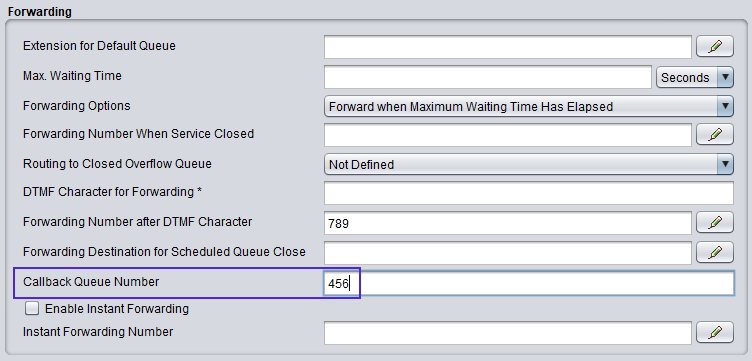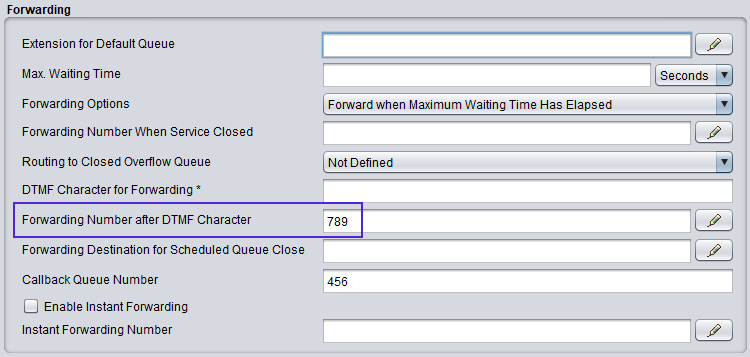Queue Callback
The queue callback function is a service that allows customers to leave a callback request to an IVR. The function involves the Callback IVR application and Callback Dialer Service and two queues, a customer service queue and a callback queue. The callback request can be handled in the system for example in the following way:
-
A customer calls to a service queue. If there are no free agents, the call is transferred to IVR (the Callback IVR application) where the customer is given an option to leave a callback request. Alternatively, the customer leaves the request via a web service, or from another application that uses the restful interface.
-
The callback request is stored into the database from which the Callback Dialer Service reads the request.
-
Callback Dialer Service then calls to the callback queue and allocates the call to a free agent.
If no agent answers the call, it is disconnected, and Callback Dialer Service redials the call after 5 minutes at the earliest.
-
When an agent answers the call, Callback Dialer Service calls to the customer, and these calls are then connected.
It is possible to configure the system in so that in case the customer cannot be reached during the first call, a retry can be scheduled. For more information, see Configuring Queue Callback Settings.
-
The customer receives a call from the original queue number.
Web Callback
This feature is available for on-premise systems only. In other cases, see Restful Contact Management Interface option.
As of SP07, it is also possible to use web callback. To install the web service, see the Installation Guide, and configure the actual callback function as explained below. Customers can access the web forms in the following addresses:
-
Immediate web callback: http://[your site]/ChatAS/WebCallBackForm.aspx
-
Scheduled web callback: http://[your site]/ChatAS/WebCallBackForm.aspx?formtype=1
Callback Request via Restful Interface
It is possible to create callback requests also via Restful Contact Management Interface (CMI). For more information, see the interface document (as of 1911).
Configuration
To use the callback function in your system:
-
Configure the system-wide queue callback settings.
-
Create a callback queue:
-
Create the queue as any other phone queue.
Queue Size defines how many callback requests can be left. When this value is exceeded, the Callback IVR application does not allow any new requests. For information about values for settings Max. Waiting Time and Reference Timestamp for Calculating Queuing Time, see Configuring Queue's Contact Management Settings.
-
Note:Attach a callback script to the queue. Script is not needed for Communication Panel as the mandatory call result is given in the Communication Panel UI.
This step is required only if you use CDT. If both CDT and Communication Panel are used in the same system, it may be reasonable to use separate callback queues for them.
For CDT, a default script is available in the system. The script contains a mandatory question regarding the call attempt result ({CBR_LASTRESULT}). If the customer is, for example, busy or there is no answer, a new call can be scheduled automatically.
Make sure that the agents who handle these callback requests fill out the script. Otherwise the request, even if it had been successful, is not cleared from the system.
-
Define a schedule for the queue.
You can use the same schedule as for the customer queue.
Since providing the call result is mandatory, the agents who use IP desk phones or serve in queues as external agents cannot handle callbacks.
-
-
Create a customer service queue (if it does not exist yet) and define the callback-related settings for it in the Contact Management block:
-
Add the callback queue number.
Figure 1. Callback Number 
-
Forward the calls to the callback service in one of the following ways:
-
Define the value for Max. Waiting Time.
-
Enter the IVR number into the Extension for Default Queue field.
-
Choose the Forward when Maximum Waiting Time Has Elapsed option for the Forwarding Options field.
The call is transferred to the callback service when the defined waiting time is exceeded.
Figure 2. Forwarding Option 1 
Or
-
Define the forwarding number after the DTMF character for the queue.
The default DTMF character is the pound (#) key but you can change it in the DTMF Character for Forwarding field.
Figure 3. Forwarding Option 2 
-
Use an audio prompt to instruct the customers on how to leave a callback request (for example the InQueueCB prompt:
Your call is in a customer service queue. To leave a callback request to our customer service, press the pound (#) key. To continue queuing, please wait on the line.
).
-
-
If skill reduction is defined for the customer service queue, a callback is offered to an agent according to the skill requirements that may have already been reduced in the customer service queue. If you also want to use skill reduction when offering callbacks to agents, configure it also for the callback queue. For more information on skill reduction, see Defining Skill Reduction Values.
